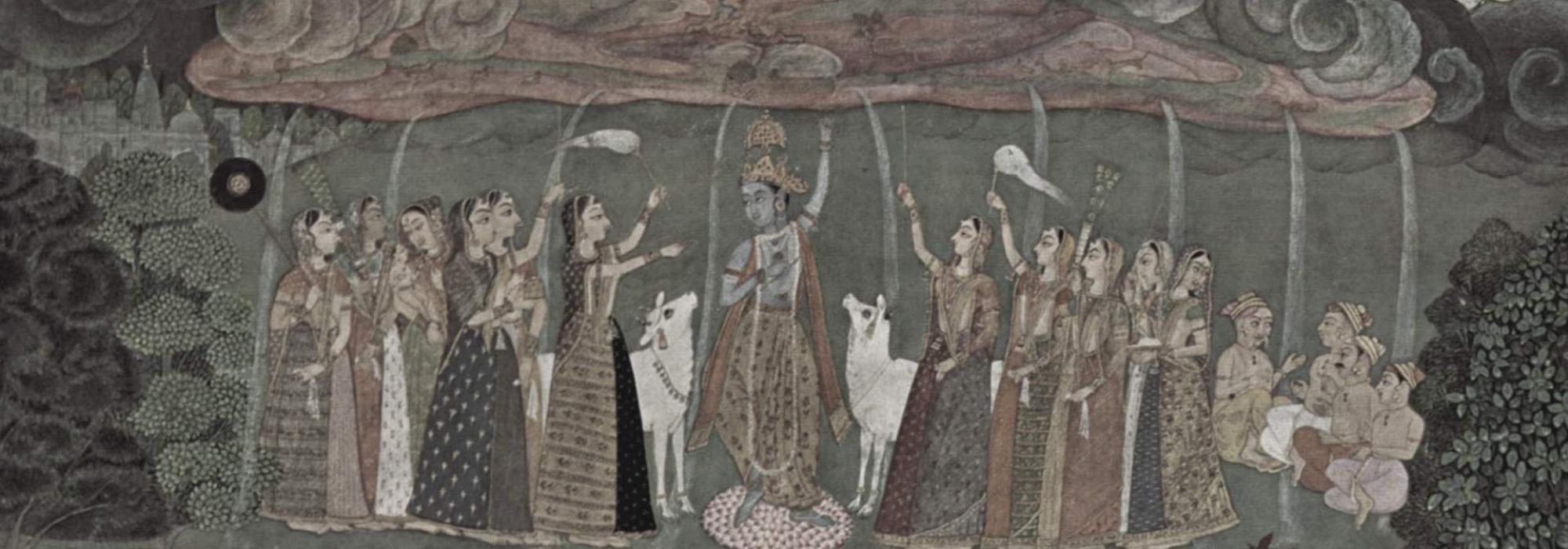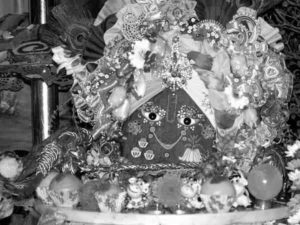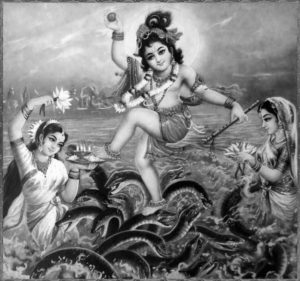Fascinated by the Mahābhārata, Dr. S L Bhyrappa wrote the novel Parva in the 1970s, which narrated the human story of the epic, keeping aside the fantastical elements. In Parva, while referring to the character of Krishna, Vidura tells Dhritarashtra, “You’re completely mistaken about Krishna. He is such a person that even if the Pandavas die on the battlefield, he will make Kunti or Draupadi the queen and get them to rule the kingdom. He won’t give a damn to your wicked children!”
Krishna never stood for any individual; he stood for dharma.
What about Rama then? Did he not stand for dharma? Indeed, Rama too stood for dharma. If in one instance, he was adhering to putra-dharma, in another instance he adhered to pati-dharma. He stood for the dharma of brotherhood in one instance and in another, he stood for the dharma of parenthood. At the level of family and relationships, he stuck to dharma.
Did Krishna follow putra-dharma or pati-dharma or pitr-dharma in a big way? He loved and respected his parents but was ready to go away into the world without being overwhelmed by their presence. He treated his wives well but was quite comfortable on his own. And in the matter of his children, he was particularly aloof to the point of being nasty to them if they were ill-behaved. He wasn’t a great father. In the end, when his kinsmen began fighting with themselves, he himself took a weapon and ensured their destruction without remorse or pain. He loved them so much, he toiled for them, but when they turned away from dharma, he went against them!
Krishna didn’t identify strongly with any individual. His acts were not for the benefits of a particular family. Every action of his was for the larger welfare of society. Was he like the proverbial helper of the world but a destroyer of the home? No, he wasn’t. He merely treated the world as his home and did what will contribute to the larger good. When someone is working in the social sphere, they should consider all the good that happens to the world as good for them too. If they lack that attitude, they will not find joy in helping the world. Krishna’s thinking was simple: if something will be good for ten people, it will be good for me too. How simple and yet not at all easy!
Rama says, whatever happens to my family—good or bad—is what happens to him. But Krishna says, whatever happens to the society is what happens to me! Growing up in Vrindavana, he moved around with many cowherd boys and girls. He is clearly a gifted child but he never tried to show that he is different or special. He was moving so naturally with friends, with neighbours.
And how do we know that he was a gifted child? One of the reasons is that he took up social causes even as a child. He didn’t wait for someone to instruct him or for external motivation. He just went about solving the problems around him. Be it the killing of various demons, the taming of Kaliya, or the Govardhana mountain episode – basically he went to help others keeping in mind the larger good.
Those who work for the sake of their families often uphold family values. Since the family values are quite established, one generation to another does not see a vast change. Society is far more complicated, for there are several people coming together with various backgrounds and worldviews. All these people come together to work for a certain cause. The values are not so established. And it is difficult to impose upon another. In the context of the family, the blood relationship often acts as an agent of compromise and a means to bind people. Society doesn’t have this, so the stark differences are harder to reconcile. It was in such an atmosphere of diversity that Krishna had to operate. Amidst divergent views and ideas, Krishna tried to find common ground.
Even as a child, he told his people that instead of blindly imitating the Indradhvajotsava, which was a celebration of the city, why not worship the Govardhana mountain, which was their very own. Indradhvajotsava was an important festival at one point of time but its pre-eminence was waning, for it had transformed into an ugly exhibition of pomp and splendour under the rule of Kamsa. It was initially meant to be a celebration in early autumn to offer gratitude to Indra, who was kind enough to give bountiful rains to the land during the monsoon. People came together, offered worship to Indra, and dance, sing and eat together. In Kamsa’s regime, it had transformed into a needlessly pompous affair with men and women indulging their senses for extended periods of time.
Such corruption is typically seen in festivals that are celebrated at the scale of society, particularly when the ruler is misusing for his own base ends. The celebrations at the family level are far more controlled and restricted. The social festivals are quick to gain momentum and also quick to degenerate into something silly. Instead of trying to cover up the cracks in the existing festival, Krishna tried to offer a simpler alternative. Why not worship the Govardhana mountain, which is a part of the landscape and which is responsible for nourishing the forests around it and the streams? Krishna was not against Indra; in fact he has performed many yajñas where the main deity is Indra. What he opposed was the needless pomp. He tried to change the people’s perspective in order to return to the spirit of the celebration. He had to convince them and touch their hearts, which he did. After everything, when it rained so heavily, the people must have blamed him. But he helped them even during that time, without getting offended by their criticism.
The head of the family can tolerate the criticism of one or two people but it’s never easy to stand up against the criticism of the world. Krishna bore that burden. I have often felt that the burden of the society’s criticism was heavier for him than the burden of the Govardhana mountain itself! Did he really lift the mountain, or did he take all the cowherd families to a safe place in the mountain – there are many such questions. What is more important is that Krishna was able to bring about a change in the mindset of his community. Usually there is a fierce objection when someone tries to change a social custom, but Krishna managed to do it even as a young boy. This strength is needed for a public figure – however much people may scold or criticize him, he should not get upset or perturbed. It’s common in a family for the members to listen to the head of household, particularly when they are financially dependent. Due to this, the head of the family might have the final say. But in society, for a common man who has no authority to be able to have his way is rare. Krishna was such a person.
Rama on the other hand easily reacted to criticism. Valmiki never uses the phrase “tulyanindāstutirmauni” while describing Rama but Krishna led his life along the lines of what he says in the Gītā: “śītoṣṇasukhaduḥkheṣu samaḥ saṅgavivarjitaḥ.” This is a great social trait.
A public figure who moves around with a lot of people must have a genuine interest in the arts. This is demonstrated in Krishna’s life clearly. Even Rama was a great connoisseur of the arts. In fact, the ādikavi hails Rama as skilled in the arts. But we don’t see this in practice in Rama’s life. We see so many instances in Krishna’s life that shows us how much he loved the arts. He learnt music and dance. He participated in singing and dancing with his friends. He learnt them for his own joy but he also used it to connect with people.
Shiva too is a great dancer and singer; he played musical instruments; and was a lover of all the arts. There’s nothing surprising about that, for that is the individual ideal to attain joy. But Krishna took that trait to society, to connect with the world. Just like he could dance solo on the head of Kaliya, he could also participate in the Ras, which is a dance that needs to be done with others. It brings people together. He could dance alone or could dance with thousands on the banks of Yamuna on a moonlit night in autumn. He could play the flute and mesmerise listeners. This takes social service to the level of enjoyment, to the level of a celebration.
Another trait that is essential for a public figure is the attitude to immediately revolt against injustice. A person can sustain in public life only if he or she has such a mindset. A public figure cannot sit silently when adharma raises its ugly head. He cannot be a leader if he remains silent owing to some formality, courtesy, or a sense of magnanimity. Krishna never remained silent in the face of injustice. He always fought adharma. It didn’t matter who the other person was.
Rama was plagued by niceties and courtesies at places. When Kaikeyi asked Dasharatha to send Rama away, he doesn’t say anything. He continues to respect Kaikeyi. He could have turned around and said, “This is foolishness! Your demands will take the life of my father and will make your son hate you. Don’t do such a thing!” But he didn’t say a word. If it had been Krishna, he would have surely said it without fear or hesitation.
People in the public domain who seek the welfare of the world should speak the truth directly and immediately sans fear. They should clearly spell out what is right and what is wrong, even if it seems like a slap on the face. Of course, one can say it in gentle words but one must say it. In Rama, there is a certain amount of hesitation. Family life demands such niceties and compromises. If relationships break in families, it is difficult to repair. But in society, it does’t really matter. A public figure doesn’t have to care for the other person’s feeling while speaking the truth; they are not from the same family, they don’t have to live under the same roof. When it comes to a family, one has to be protective. With society, one can be clinical. Krishna brought this thinking even to his family in a wonderful way, as we will see in the following episodes.
To be continued.
This serialized article has been translated by Hari Ravikumar from the author’s Kannada lecture held at the Gokhale Institute of Public Affairs, Bangalore in 2009.


















































